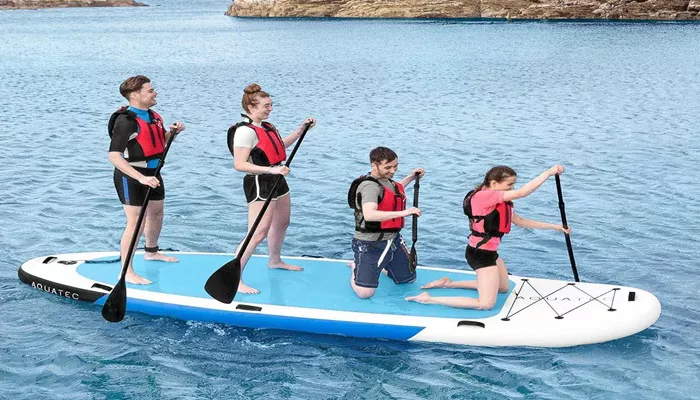Stand up paddle boarding, also called SUP, is one of the fastest-growing water sports in the world. It’s a fun, relaxing way to enjoy lakes, rivers, and oceans. It also gives you a full-body workout and helps improve your balance and core strength. But if you are new to SUP, you may wonder: What do I need to start?
This guide is made for beginners. It explains what stand up paddle boarding is, what equipment you need, how to get started, and useful tips to help you feel confident on the water. Everything is broken down into simple parts so you can learn step-by-step.
What Is Stand up Paddle Boarding?
Stand up paddle boarding is a water sport where you stand on a large, stable board and use a long paddle to move across the water. You can paddle on lakes, rivers, and the ocean. Some people do it for fun, some for fitness, and some for adventure or yoga.
SUP is great for all ages and skill levels. You do not need to be an expert swimmer or athlete to begin. You can start slow, practice in calm water, and improve with time.
Why Try Stand up Paddle Boarding?
There are many reasons people love SUP. Here are some of the top benefits:
Easy to Learn: Most beginners can stand and paddle in less than one hour.
Good Exercise: It works your legs, arms, and core muscles without heavy impact.
Low Stress: Paddling on calm water can help reduce anxiety and improve focus.
Flexible Activity: You can go fast or slow, do yoga, fish, or just float and relax.
All-Age Friendly: From kids to seniors, anyone can enjoy it at their own pace.
Whether you’re looking to explore nature, build strength, or enjoy peaceful time on the water, SUP has something for you.
What Equipment Do You Need to Start SUP?
Before your first time paddle boarding, you need to get the right gear. You don’t need the most expensive equipment. You just need basic, beginner-friendly items.
1. Paddle Board
The most important item is your paddle board. There are two main types:
Inflatable SUPs: Easy to carry, store, and very beginner-friendly. Great for calm water.
Hard SUPs (solid): Stronger, faster, but harder to transport. Better for waves or long distances.
For beginners, inflatable boards are usually the best choice. Look for a board that is:
Wide (30–34 inches): Gives more balance.
Long (10–11 feet): Easier to glide across water.
Thick (5–6 inches): Offers stability and float support.
2. Paddle
SUP paddles are long and lightweight. Most are adjustable. A good beginner paddle should reach about 6 to 10 inches above your head when standing.
Choose a paddle that is:
- Lightweight (fiberglass or aluminum)
- Comfortable to hold
- Easy to adjust
3. Leash
A leash connects your ankle to the board. If you fall, your board won’t drift away. Always wear a leash—it’s an important safety tool.
4. Personal Flotation Device (PFD)
Safety always comes first. In many areas, laws require a life vest or flotation device when paddle boarding. Choose a PFD that is lightweight and allows free arm movement.
5. Proper Clothing
Wear clothes that fit the water temperature and weather. Examples:
Warm weather: Swimsuit, rash guard, or board shorts
Cool water: Wetsuit or drysuit
Sunny days: Sunglasses, hat, and sunscreen
You may also want water shoes for foot protection and better grip.
How to Start Stand up Paddle Boarding
Once you have the gear, you’re ready to begin. Follow these steps for your first SUP session.
1. Pick the Right Location
Start in calm, flat water with little to no wind. A small lake, slow-moving river, or quiet bay is ideal. Avoid waves, strong currents, and busy boat areas.
2. Set Up Your Board
Inflate your board (if it’s inflatable) to the recommended PSI. Attach the leash and paddle. Make sure the fin is secure—it helps with balance and direction.
3. Start on Your Knees
Before standing, kneel in the center of the board. Hold the paddle with both hands. Paddle around to feel how the board moves. This helps you gain confidence and balance.
4. Stand Up Slowly
When ready to stand:
- Place your paddle across the board.
- Put one foot where your knees were.
- Place the second foot next to it.
- Slowly rise to a standing position.
- Keep your knees slightly bent and look forward, not down.
5. Learn the Paddle Stroke
Use your core, not just your arms. Reach forward with the paddle, place the blade in the water, and pull it back along the side of the board. Switch sides every few strokes.
6. Practice Turning
To turn, paddle more on one side. To make a sharp turn, place the paddle behind you and sweep it in a wide arc.
Tips for Beginner Paddle Boarders
Here are some extra tips to make your first experience safer and more enjoyable:
Don’t look down: Keep your eyes on the horizon to help balance.
Keep your feet shoulder-width apart: This gives you more stability.
Use your legs and core: Don’t rely only on your arms to paddle.
Stay near shore: You’ll feel safer and can rest if needed.
Check the weather: Avoid strong winds, rain, or changing tides.
Take breaks: Sit or kneel if you get tired.
Common Beginner Mistakes to Avoid
Knowing what not to do can help you improve faster.
Using the paddle backward: Make sure the bent side faces forward.
Standing too far forward or back: Stay in the center of the board.
Locking your knees: This can throw off your balance.
Trying to go too fast: Take your time and focus on technique.
Ignoring safety: Always wear a leash and PFD.
Conclusion
Stand up paddle boarding is a wonderful way to enjoy the outdoors, get fit, and try something new. It’s fun, low-impact, and perfect for all skill levels. Starting is simple if you follow the right steps and use beginner-friendly gear.

